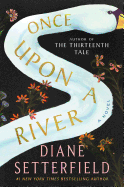
A story with a fairytale title like Once Upon a River promises to transport readers to another place and time, and New York Times bestselling author Diane Setterfield doesn't disappoint. In her third novel, Setterfield (The Thirteenth Tale) embarks on a fantastical journey, one with an abundance of magic and mystery.
"As is well-known, when the moon hours lengthen, human beings come adrift from the regularity of their mechanical clocks. They nod at noon, dream in waking hours, open their eyes wide to the pitch-black night. It is a time of magic. And as the borders between night and day stretch to their thinnest, so too do the borders between worlds. Dreams and stories merge with lived experience, the dead and the living brush against each other in their comings and goings, and the past and present touch and overlap. Unexpected things can happen."
Setterfield's lyrical prose leads readers to the Swan at Radcot, an inn along the Thames River where, in 1887, villagers gather in the evenings to drink and tell stories. Well-worn folktales and legends known by heart are embellished for dramatic effect and generously shared among strangers and kin alike. Everyone knows, for example, about the river gypsies on the Thames and the eternal bargain they struck with Quietly, a mute ferryman whose daughter died in a river accident. In exchange for Quietly's perpetual vigilance as the river's watchman, protector and guide, his daughter was returned safe and sound.
On the night of the winter solstice, a grotesquely battered and bloodied stranger bursts into the Swan. ("Was it a monster from a folktale? Were they sleeping and this was a nightmare?") Adding to the scene's macabre quality: the man is holding the lifeless body of a young girl, initially thought by the stunned spectators to be a large puppet. Astonishingly, inexplicably, the child turns out to be very much alive.
The mysterious circumstances that caused the child to be found in the Thames River become the subject of much speculation among the Swan's frequent storytellers and drinkers. They learn that the stranger is Henry Daunt, a photographer from Oxford who specializes in river scenes. But the identity of the child, who appears to be about four years old and who doesn't speak, remains unknown.
As the story of the mysterious event at the Swan travels from person to person, several people descend on the inn. Rita Sunday, a nurse, cares for Henry and the girl after their trauma on the river. A middle-aged woman named Lily White insists that the toddler is her younger sister, Ann--despite their apparent age difference of three decades. When Bess and Robert Armstrong learn about the girl, they believe she could be Alice, their granddaughter and a link to their estranged son, Robin. Or perhaps she is Amelia, Mr. and Mrs. Vaughan's daughter, who was kidnapped from her bedroom two years prior and hasn't been seen since.
Several of these possibilities are quickly disregarded by the characters because of their inherent individual and collective assumptions. Throughout Once Upon a River, Setterfield challenges her readers not to make the same mistake, to suspend any long-held beliefs and look beyond the seemingly impossible. Though the story is set in the late 19th century, Setterfield's characters and their prejudices are recognizable today. Take the Armstrongs: Bess walks with a limp and is the target of familiar misconceptions and stereotypes about people with disabilities. Her husband, Robert, also experiences discrimination and injustice: "The blackness of his skin made him the outsider, and his height and strength that would have been an advantage to any white man only made people more wary.... As often as not, people reserved their curtness for people who were, like him, unfamiliar. Difference was upsetting, and people armed themselves in aggression when they met it."
Each character supports Setterfield's theme of souls capable of spanning time, and of porous borders between the known world and those in the past or future. Once Upon a River's mysterious atmosphere enhances the growing sense that, as inexplicable and distinct as their individual stories may seem, Lily White, the Armstrongs and the Vaughans must all be connected. Setterfield's approach to presenting each character's backstory evokes the Thames River's path and its tributaries, with each stream being part of a whole.
Her enchanting language, quaint setting and engaging characters make Once Upon a River a deeply satisfying, thought-provoking story reminiscent of the most beloved fairytales. It is a reminder of storytelling's importance and its ability to bond souls together despite individual differences and the passage of time. --Melissa Firman

